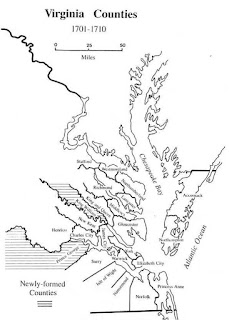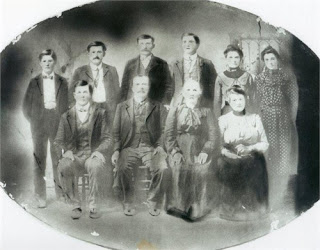The Hildreth In-Laws: The Faurots
The Hildreth In-Laws: The Faurots
In the last
post, we left off with Rees Bowen Hildreth’s death in Lee County, Iowa in
December, 1849. His death, of a self-inflicted gunshot, left his 41-year-old
widow, Martha Faurot Chapman Hildreth, with five minor sons: 17-year-old
Isaac Chapman (from her first marriage to Stuckley Chapman), nine-year-old Henry
Hildreth, eight-year-old John Hildreth, three-year-old Rees Hildreth (my
generation’s second great-grandfather) and infant Eli Hildreth.
Martha
Faurot Chapman Hildreth was born in Gorham Township, Ontario County, New York
in 1808, the fourth child of eight to my generation’s fourth great-grandparents,
Jacob Faurot (1775-1853) and Hannah Cory (1779-1844).
The Faurots (sometimes spelled "Farotte" or "Faurote") were probably French, emigrating to North America sometime before 1700. My generation’s
eighth great-grandfather, James Faurot (1654-1725) settled near Rahway, New
Jersey, and the next three generations--Henry (1680-1732), David (1708-1760), and Henry (1730-1810)--were landowners in and around
Piscataway and Woodbridge, New Jersey.
My generation’s
fifth great-grandparents were Henry Faurot (1730-1810) and Alche (Eleanor)
Enyard (1735-1800). Eleanor's Enyard ancestors arrived from Flanders in 1648 on The
Concord, the last Dutch ship colonizing New Netherlands in 1664. The Enyards
owned land on Staten Island for three generations before migrating to
Woodbridge, New Jersey. Eleanor Enyard married Henry Faurot there in about 1755.
After 1768, Henry Faurot sold his holdings in New Jersey and moved his family first to New York City and then to New Cornwall, New York, just prior to the Revolution. In a prior post, we discussed that Joseph Hildreth and his family lived in Cornwall and moved to Virginia during the Revolution. It is not clear whether the Faurots and Hildreths were in Cornwall at the same time, but it is interesting that two families with history in Cornwall, New York connected three generations later in Indiana. The "Farotte" farm in Cornwall is represented in military maps from the Revolution a few miles away from the fort (now the United States Military Academy) at West Point, New York:
Henry Faurot (1730-1810) participated in the Revolution and has been assigned Patriot Number P-156925, qualifying his direct descendants for membership in the Sons of the American Revolution. There are several differing accounts of his participation in the Revolution that will require additional research to prove. According to family accounts detailed in Interweaving the Stivers, Faurot and DuPuy Families, by Frank Fremont Reed (link), Henry Faurot provided timber from his lands in New Cornwall to General George Washington for construction of Fort Putnam, located above West Point on the Hudson River. It is also thought he may have provided a sailing vessel and teams of horses for transporting the timber to that location. The most riveting family account is that Henry and his oldest son, John Faurot, had their farm destroyed by British forces and were taken prisoner in the process. According to this account, the British sentenced them to death for aiding the rebels. After George Washington threatened to retaliate against prisoners loyal to the British, they were released. According to the family legend, Henry continued to provide services to Washington, who spent some evenings at the Faurot house with Lafayette .
Perhaps Henry Faurot’s greatest contribution to the American Revolution was the military service of three of his sons, John, David and James Faurot. It is believed that contribution won Henry a land grant to an acreage in Ontario County, New York, located near the northern tip of Lake Canandaigua, in the Finger Lakes Region of upstate New York. Henry and his sons relocated there after the Revolution around 1800.
Henry's son, Jacob Faurot, was born in New York in 1775 and married Hannah Cory (my generation's fourth great-grandparents) in 1801, about the time Henry and family made the move to upstate New York. The Corys were Scots, first
coming to Massachusetts in 1638. John Cory (1611-1685) left Massachusetts to
help settle the towns of Southold and Southampton on Long Island about the same
time Thomas Hildreth did the same. Given the size of the settlements there and
the prominence of each family, I think it is highly likely the Corys and the
Hildreths were acquainted in Southampton, New York in the late 1600s.
The next
two Cory generations, Isaac Cory (1649-1701), David Cory (1690-1758) remained in
Southampton. My generation’s fifth great-grandfather, Benjamin Cory (1736-1791), left Southampton and settled in Orange County, New York, yet another historical
and geographical connection between the ancestors of Rees Bowen Hildreth and
Martha Faurot Chapman Hildreth. Hannah Cory Faurot was born to Benjamin Cory
and Hannah Smith on July 10, 1779 in Orange County New York.
According to Frank Fremont Reed in Interweaving the Stivers, Faurot and DuPuy Families, after his service in the War of 1812, Jacob Faurot, as part of a multi-generational family move, migrated first to Cincinnati, Ohio and then to Franklin County, Indiana. Jacob received a land grant in Franklin County, Indiana, in 1832, just a few miles away from the land grant received by Henry Hildreth in 1823. The acreages each received are shown on the map here, approximately half-way between Cincinnati Ohio and Indianapolis, Indiana.
In 1830 in Franklin County, Martha Faurot married Stuckley Chapman, and they had two sons, Marvin and Isaac. She became a widow in 1838, about the same time Rees Bowen Hildreth was widowed by the death of his first wife, Martha Buchanan Hildreth. Rees Bowen Hildreth and Martha Faurot Chapman married soon thereafter. Martha was approximately 18 years younger that Rees.
By the 1840
census, Rees and Martha Faurot Hildreth and family moved to Richland Township
in Rush County, Indiana. Rees' brother Henry had land in Richland
Township, but by 1840, he and his family moved on to Fentress County,
Tennessee. Thus, it is possible that Rees and Martha assumed operation of the farm that was
originally operated by Henry. The following plat map of Laurel Township, Indiana shows the location of Faurot and Hildreth properties in 1858 when they were owned by Jacob's son John Holliday Faurot and Rees' son Joseph:
Rees Bowen Hildreth and
Martha Faurot Chapman Hildreth had four sons, The first two, Henry and John, were born
in Indiana in 1840 and 1841, respectively. Soon thereafter, with the family of Martha's sister, Anna Christena Faurot Abercrombie, Rees, Martha and their sons moved to
Des Moines Township, Lee County, Iowa. Des Moines Township is located just west
of the town of Keokuk, in the extreme southeast corner of Iowa on the border with Missouri:
Rees Bowen and Martha operated a farm of approximately 80 acres, raising corn, wheat, cattle and hogs.
Martha’s
father, Jacob Faurot, joined them in Iowa, probably after the death of his wife, Hannah
Cory Faurot, in 1844. The last two children of Rees Bowen Hildreth and Martha Faurot Hildreth,
Rees and Eli, were born in Iowa in 1846 and 1849.
Tragically, Rees Bowen Hildreth died of a self-inflicted gunshot in December, 1849, leaving his widow with five minor sons. After his death, an estate was opened in Lee County which indicates she continued to operate their farm. By the time Martha’s father, Jacob Faurot died a few years later in 1853, they had been joined in Lee County by Martha's siblings Isaac Faurot, Mehitable (May) Faurot Enyart, Mary Faurot Porter, and Stella Faurot Huffman, leaving only brothers John Holliday Faurot and William Henry Faurot in Indiana.
Jacob Faurot is buried in a derelict pioneer cemetery in Des Moines Township. It is likely Rees Bowen Hildreth is buried there in an unmarked grave.
Iowa conducted a state census in 1854 which shows that Martha and her five sons continued to reside in Lee County through that date. However, by 1860, she moved to Liberty Township, Adair County, Missouri. Liberty Township is located just west of Kirksville, Missouri:
A review of the census entries indicates that her son John Hildreth, born in Indiana in 1841, was no longer living. There is no record of his death or burial. Isaac Chapman, her son from her first marriage to Stuckley Chapman, was residing in Putnam County, Missouri in 1860. He was married with two children at that time. Martha's sister, Anna Christena, was also living near Martha in Liberty Township in 1860. She was also a widow and was living with her three sons. Martha's siblings Isaac Faurot, Mary Porter and May Enyart remained in Iowa.
By 1870, Martha Hildreth moved to Union Township, Sullivan County, Missouri with son, Eli Hildreth remaining in her household. Union Township is located east of the town of Milan, Missouri:
Isaac Chapman, his wife, and five children were near to her in Union Township. Her sons Henry and Rees Hildreth had enlisted in the 27th Missouri Infantry Regiment during the Civil War and were no longer living with her.
Martha Faurot Chapman Hildreth died on May 7, 1874, presumably in Sullivan County, Missouri. No record of her death or burial exists. Her son Rees Hildreth, married Rachel Belzer (my generation's second great-grandparents) just a few months later in Sullivan County on July 20, 1874.
In the next post, we will review the Civil War service of the Hildreths, Faurots and Belzers in our family tree.











Thank you for the information on the Rees Hildreth Family I found it very helpful working on my Chapman Family Tree
ReplyDelete